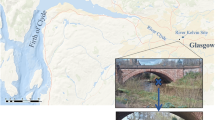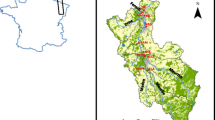Abstract
The impact particulate-phosphorus (particulate-P) has on eutrophication of aquatic systems that greatly depends on its composition. As a result, analysis methods for evaluating particulate-P speciation must be capable of identifying and/or quantifying the wide range of forms particulate-P can take. In the present study, we compare the particulate P speciation of the fine and colloidal fractions of riverbed sediment and suspended matter from two rivers in the Lake Geneva basin (French Alps) as determined with chemical extractions to results of a combined Transmission Electron Microscopy and Energy Dispersive Detection (TEM–EDS) analysis of the same samples. TEM–EDS provides semi-quantitative information about the distribution of P throughout the solid fraction of a sample and on the diversity of carrier phases, which are identified by their morphology and stochiometry. EDS-detectable quantities of phosphorus were found in 15–35% of the particles in the samples analyzed. As expected, particulate-P existed in a wide variety of forms, mostly associated with Al, Fe, Ca and Si. Some types of particles, often well-crystallized phosphate minerals, had high P contents (10–30%), but the dominant carrier phases of P were diffuse matrices of particles with low P contents (<5%). These matrices had a wide range of chemical compositions and included clay minerals, crystallized and amorphous phases of Fe, as well as intermediary components. Classical chemical extractions showed major differences in P content and speciation between the upstream and downstream sediment samples. The downstream samples showed higher frequencies of particles containing P, a larger diversity of carrier phases, a higher contribution of clays as carrier phases of P, and the presence of a new fraction with Al and Fe amorphous minerals. The processes that create and select carrier phases of particulate-P are part of the general dynamics of P within a watershed.






Similar content being viewed by others
References
Barbanti A, Bergamini MC, Frascari F et al (1994) Critical aspects of sedimentary phosphorus chemical fractionation. J Environ Qual 23:1093–1102
Beauchemin S, Simard RR, Cluis D (1996) Phosphorus sorption–desorption kinetics of soil under contrasting land uses. J Environ Qual 25:1317–1325
Beauchemin S, Simard RR (1999) Soil phosphorus saturation degree: review of some indices and their suitability for P management in Québec, Canada. Can J Soil Sci 79:615–625
Beauchemin S, Hesterberg D, Chou J et al (2003) Speciation of phosphorus in phosphorus-enriched agricultural soils using X-ray absorption near-edge structure spectroscopy and chemical fractionation. J Environ Qual 32(5):1809–1819
Chang SC, Jackson ML (1957) Fractionation of soil phosphorus. Soil Sci 84:133–144
CIPEL (1988) Rapport de l’étude des pollutions diffuses dans le bassin lémanique. Commission Internationale pour la Protection des Eaux du Léman, Lausanne
Dorioz JM, Pilleboue E, Ferhi A (1989) Dynamique du phosphore dans les bassins versants: importance des phénomènes de rétention dans les sédiments. Water Res 23(2):147–158
Dorioz JM, Pelletier JP, Benoit P (1998) Propriétés physico-chimiques et biodisponibilité potentielle du phosphore particulaire selon l’origine des sédiments dans un bassin versant du lac Leman (France). Water Res 32(2):275–286
Elsass F, Beaumont A, Pernes M, Jaunet AM, Tessier D (1998) Changes in layer organization of Na and Ca exchanged smectite during solvent exchange for embedment in resin. Can Mineral 36:1325–1333
Fransolet AM, Keller P, Fontan F (1997) The alluaudite group minerals: their crystallochemical flexibility and their mode of formation in the granite pegmatites. Mineralogical Society, Spring Meeting “Phosphates: Biogenic to Exotic”
Golterman HL (1976) Sediment as a source of phosphate for algal growth. In: Golterman HL (ed) Interaction between sediment and fresh waster. Junk Publishers, The Hague, The Netherlands, pp 286–293
Golterman HL (1996) Fractionation of sediment phosphate with chelating compounds: a simplification and comparison with other methods. Hydrobiologia 335:87–95
Golterman HL, Booman A (1988) Sequential extraction of iron-phosphate and calcium-phosphate from sediments by chelating agents. Verh Inte Ver Limnol 23:904–909
Hieltjes AHM, Lijklma L (1980) Fractionation of inorganic phosphates in calcareous sediments. J Environ Qual 9:405–407
Holtan H, Kamp-Nielsen L, Stuanes AO (1988) Phosphorus in soil, water and sediment: an overview. Hydrobiologia 170(1):19–34
Jaquet JM, Davaud E, Rapin F et al (1982) Concept and associated statistical methodology in geochemical study of lake sediments. Hydrobiologia 91:139–146
Jarvie HP, Withers PJA, Neal C (2002) Review of robust measurement of phosphorus in river water: sampling, storage, fractionation and sensitivity. Hydrol Earth Syst Sci 6:113–131
Jordan-Meille L (1998) Modes de transferts de phosphore d’origine diffuse dans un petit bassin versant rural lémanique. These EPFL.
Jordan-Meille L, Dorioz JM (2004) Soluble phosphorus dynamics in an agricultural watershed. Agronomie 24:237–248
Lienemann CP, Heissenberger A, Leppard GG, Perret D (1998) Optimal preparation of water samples for the examination of colloidal material by transmission electron microscopy. Aquat Microb Ecol 14:205–213
Lindsay W, Vlek PL, Chien SH (1989) Phosphate minerals. In: Minerals in soil environments (2nd edn). SSSA Book Series 1, pp 1089–1130
Martin RR, Smart St, Kazaki K (1988) Direct observation of phosphate precipitation in the goethite/phosphate system. Soil Sci Soc Am J 52:1492–1500
McDowell RW, Sharpley AN (2001) A comparison of fluvial sediment phosphorus (P) chemistry in relation to location and potential to influence stream P concentrations. Aquat Geochem 7:255–265
Murphy J, Riley JP (1962) A modified single solution method for the determination of phosphate in natural waters. Anal Chim Acta 27:31–36
Nicoud G, Triganon A, Guiter F, Andrieu-Ponel V, Dupuy D (2006) Cartography and chronology of the glacial advances in the Lemanic area since MIS 5. In: INQUA-SEQS subcommission on European quaternary stratigraphy quaternary stratigraphy and evolution of the Alpine region in the European and global framework, pp 8–13
Olsen S, Cole C, Watanabe F et al (1954) Estimation of available phosphorus in soils by extraction with sodium bicarbonate. USDA Circular 939, US Gov. Print. Office, Washington, DC
Pardo P, Rauret G, López-Sánchez J (2003) Analytical approaches to the determination of phosphorus partitioning patterns in sediments. J Environ Monit 5(2):312–318
Pierzynski GM, Logan TJ, Traina SJ et al (1990) Phosphorus chemistry and mineralogy in excessively fertilized soils: quantitative analysis of phosphorus-rich particles. Soil Sci Soc Am J 54(6):1576–1583
Pilleboue E (1987) Origines, bilans et mécanismes de transfert du phosphore et de l’azote d’un bassin versant vers un lac. Thèse de l’Université de Paris VI
Rodier C, Robert M (1995) Une approche au niveau particulaire de la spéciation du phosphore dans les sols. Comptes Rendus de l’Académie des Sciences série IIa 321:769–774
Ruban V, López-Sánchez JF, Pardo P et al (2001) Development of a harmonised phosphorus extraction procedure and certification of a sediment reference material. J Environ Monit 3(1):121–125
Ruttenberg KC (1992) Development of a sequential extraction method for different forms of phosphorus in marine sediments. Limnol Oceanogr 37(7):1460–1482
Schwertmann U, Herbillon AJ (1992) Some aspects of fertility associated with the mineralogy of highly weathered tropical soils. In: Lal R, Sanchez PA (eds) Myths and science of soils of the tropics. SSSA Spec. Publ. 29. SSSA and ASA, Madison, WI, pp 49–59
Sen Tran T, Giroux M (1987) Disponibilités du phosphore dans les sols neutres et calcaires du Québec en relation avec leurs caractéristiques chimiques et physiques. Can J Soil Sci 67(1):1–16
Sharpley AN, Gburek WJ, Folmar G et al (1999) Sources of phosphorus exported from an agricultural watershed in Pennsylvania. Agric Wat Manag 41(2):77–89
Shenker M, Seitelbach S, Brand S, Haim A, Litaor MI (2005) Redox reactions and phosphorus release in re-flooded soils of an altered wetland. Eur J Soil Sci 56(4):515–525
Sims JT, Simard RR, Joern BC (1998) Phosphorus loss in agricultural drainage: historical perspective and current research. J Environ Qual 27:277–293
Soil Survey Staff (1999) Soil taxonomy—a basic system of soil classification for making and interpreting soil surveys, 2nd edn. USDA-NRCS Agric. Handb. 436. US Gov. Print. Office, Washington, DC
Stone M, English MC (1993) Geochemical composition, phosphorus speciation and mass transport of fine-grained sediment in two Lake Erie tributaries. Hydrobiologia 253(1–3):17–29
Triplehorn DM, Bohor BF (1983) Goyazite in Kaolinitic altered tuff beds of cretaceous age near Denver, Colorado. Clays Clay Miner 31:299–304
Vollenweider RA (1968) The scientific basis of lake and stream eutrophication with particular reference to phosphorus and nitrogen as eutrophication factors. Technical Report DAS/DS1/68.27. Organization of Economic Cooperation and Development, Paris
Warren LA, Haack EA (2001) Biogeochemical controls on metal behaviour in freshwater environments. Earth Sci Rev 54(4):261–320
Williams JDH, Syers JK, Walker TW (1967) Fractionation of soil inorganic phosphate by a modification of Chang and Jackson’s procedure. Soil Sci Soc Am Proc 31:736–739
Worsfold PJ, Gimbert LJ, Mankasingh U et al (2005) Sampling, sample treatment and quality assurance issues for the determination of phosphorus species in natural waters and soils. Talanta 66(2):273–293
WRB (2006) World reference base for soil resources 2006, 2nd edn. World Soil Resources Reports No. 103. FAO, Rome
Acknowledgements
We dedicate this article to the late Michel Robert, former Director of Research at INRA and the originator of the present study. We gratefully thank Christophe Rodier and Anne-Marie Jaunet for their invaluable technical help in carrying out the TEM observations and the EDS counts. We acknowledge greatly the reviewers for their critical comments, which helped to improve an earlier version of this article.
Author information
Authors and Affiliations
Corresponding author
Rights and permissions
About this article
Cite this article
Poulenard, J., Dorioz, JM. & Elsass, F. Analytical Electron-Microscopy Fractionation of Fine and Colloidal Particulate-Phosphorus in Riverbed and Suspended Sediments. Aquat Geochem 14, 193–210 (2008). https://doi.org/10.1007/s10498-008-9032-5
Received:
Accepted:
Published:
Issue Date:
DOI: https://doi.org/10.1007/s10498-008-9032-5




